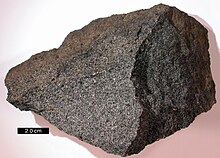Magan
Magan ( Sumerian Ma-gan ki , Assyrian Ma-kan, Ma-ka-an , Akkadian ma-kan-nu-u, ma-ak-ka-ni-tum ; spoken probably Makkan ) is the name for the area of today Oman . Based on Gudea's description of the location , the Oman region could be quickly identified: “Rock islands in the southern bulge (of the Persian Gulf )”. So far, Maništušu is the only recorded king who entered Magan in connection with a campaign and fought there against an alliance of "lords from 32 cities". He advanced with his army to the “precious metal gallery” and then had his statue made of “black stone”.
Magan was nicknamed " Kupferberg " and "Stollenproduktberg" and was an important stopover for trade between the Mesopotamus and the Indus Valley in ancient times .
Trade relations
Due to its copper mining, the country was of particular importance in the trading system of that time, as copper is needed for the production of bronze . At the height of copper production between 2200 BC. BC and 1900 BC Chr. To 2000 to 4000 tons have been promoted copper. In addition, gabbro and diorite were exported from Magan . Gudea reports on the import of diorite from Magan for the manufacture of statues. The trade was carried out with ships that had a loading capacity of up to 20 t.
Bitumen remains as fragments of sealing material that are more than 3000 years older than those found in Ra's al-Jins in Oman (2400–2300 BC) have been discovered by archaeologists in as-Sabiyah (Kuwait). In a Neolithic village on the edge of a lagoon, they found not only the expected Arab artifacts but also those of the Mesopotamian Obed culture . Presumably there was a landing stage for Mesopotamian traders. There is some evidence that Obed ceramics, which were found along the Arabian Peninsula as far as Bahrain , Qatar and on the other side of the Persian Gulf , were transported by sea and not by land.
The roughly 30 bitumen fragments, like those from Oman, show imprints of reeds and ropes on one side and crustaceans on the other. A clay model of a ship was also found in as-Sabiyah. It's only a few inches tall. On closer inspection, you can see bundles of reed that are tied together and gathered at the stern and bow, as well as a smooth surface in the middle, perhaps reed mats. All in all, the boat has all the characteristics of the Magan ships.
In addition, archaeologists found a pottery shard showing a ship similar in shape to the model. Two masts rise in the middle, connected by a rope. The same poles in the same position - was apparently that the only solution to make a reed boat could carry the sail in its lightweight construction, found himself on a Statit-squares of Mohenjo-Daro in the Indus .
Although much is known about the commercial significance of Magan, little is known about the country's political organization. But there seems to have been at least one principality or kingdom, since Naram-Sin of Akkad around 2200 BC. Of a victory over "Mani [um], the Lord of Magan".
Around 1800 BC BC Magan lost its importance with the fall of the Indus culture and the end of direct trade connections to Mesopotamia. Copper continued to be mined and exported, but Dilmun / Bahrain now attracted the middleman . At this time, Magan disappears from the Sumerian sources. One reason was probably that Mesopotamia's copper needs could increasingly be met from Cyprus .
See also
literature
- Cinzia dal Maso: The black ships of Magan . In: Spectrum of Science Special 2/2003 p. 34ff
- Wolfgang Heimpel : Magan . In: Dietz-Otto Edzard u. a .: Real Lexicon of Assyriology and Near Eastern Archeology , Vol. 7 . de Gruyter, Berlin 1990, ISBN 3-1101-0437-7 , pp. 195-199.
- P. Yule and G. Weisgerber: The Tower Tombs at Shir, Eastern Ḥajar, Sultanate of Oman. In: Contributions to general and comparative archeology (BAVA) 18, 1998, 183–241, ISBN 3-8053-2518-5 .
- P. Yule and Inge Guba: Did the Ancient Mesopotamian Royal Stone Originate in Oman? In: Adumatu 4, 2001, 41-51, ISSN 1319-8947 .
Web links
Remarks
- ↑ Wolfgang Heimpel: Magan . P. 198.

